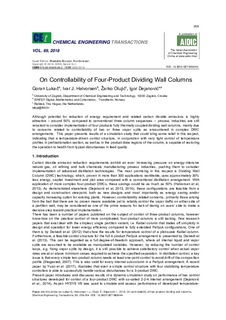| dc.contributor.author | Lukac, Goran | |
| dc.contributor.author | Halvorsen, Ivar Johan | |
| dc.contributor.author | Olujic, Zarko | |
| dc.contributor.author | Dejanovic, Igor | |
| dc.date.accessioned | 2018-12-20T13:01:44Z | |
| dc.date.available | 2018-12-20T13:01:44Z | |
| dc.date.created | 2018-12-20T10:17:20Z | |
| dc.date.issued | 2018 | |
| dc.identifier.citation | Chemical Engineering Transactions. 2018, 69 259-264. | nb_NO |
| dc.identifier.issn | 1974-9791 | |
| dc.identifier.uri | http://hdl.handle.net/11250/2578524 | |
| dc.description.abstract | Although potential for reduction of energy requirement and related carbon dioxide emissions is highly attractive – around 50% compared to conventional three column sequences – process industries are still reluctant to consider implementation of four products fully thermally coupled dividing wall columns, mainly due to concerns related to controllability of two or three vapor splits as encountered in complex DWC arrangements. This paper presents results of a simulation study that could bring some relief in this respect, indicating that a temperature-driven control structure, in conjunction with very tight control of temperature profiles in prefractionation section, as well as in the product draw regions of the column, is capable of restoring the operation to health from typical disturbances in feed quality. | nb_NO |
| dc.language.iso | eng | nb_NO |
| dc.title | On controllability of four-product dividing wall columns | nb_NO |
| dc.type | Journal article | nb_NO |
| dc.type | Peer reviewed | nb_NO |
| dc.description.version | publishedVersion | nb_NO |
| dc.source.pagenumber | 259-264 | nb_NO |
| dc.source.volume | 69 | nb_NO |
| dc.source.journal | Chemical Engineering Transactions | nb_NO |
| dc.identifier.doi | 10.3303/CET1869044 | |
| dc.identifier.cristin | 1646024 | |
| cristin.unitcode | 7401,90,26,0 | |
| cristin.unitname | Mathematics and Cybernetics | |
| cristin.ispublished | true | |
| cristin.fulltext | original | |
| cristin.qualitycode | 1 | |
